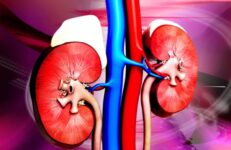Original title: Incidence and clinical impact of infective endocarditis after transcatheter aortic valve implantation. Reference: Manuel Martínez-Sellés et al. EuroIntervention 2015;10-online publish-ahead-of-print February 2015. Prosthesis endocarditis is a complication with serious clinical consequences due to its high morbimortality. Infective endocarditis (IE) in TAVI has been described in few cases and, in cohort studies, it occurs within 0 to…
Impact of kidney function on TAVI outcome
Original title: Impact of chronic kidney disease on the outcome of transcatheter aortic valve implantation: results from the FRANCE 2 Registry. Reference: Atsushi Oguri, et al. EuroIntervention 2015;10:e1-9 Globally, 13% of patients present kidney failure, which has been associated to a worse evolution not only of TAVI outcomes but also of other cardiovascular intervention outcomes. Most studies, including…
Results of the new repositionable and retrievable percutaneous valve system
Original title: Transcatheter Aortic Valve Replacement for Severe Symptomatic Aortic Stenosis Using a Repositionable Valve System. 30-Day Primary Endpoint Results From the REPRISE II Study. Reference: Ian T. Meredith AM et al. J Am Coll Cardiol 2014;64:1339–48. Transcatheter aortic valve replacement (TAVR) showed results comparable to those of surgery in patients at high surgical risk, but complications can…
Frequency, indication and evolution of emergency cardiac surgery during TAVI
Original Title: Emergent cardiac surgery during transcatheter aortic valve implantation (TAVI): insight the Edwards SAPIENS Aortic Bioprosthesis Outcome (SOURCE) registry. Reference: Holger Eggerbrecht, et al. EuroIntervention 2014;10:975-81 SOURCE register data from patients receiving transcatheter aortic valve implantation with the Edwards Sapiens valve, were analyzed; out of 2307 patients, 27 (1.2%) required emergency cardiac surgery (ECS). Valve stenosis was…
Promising results of TAVR in Bicuspid Aortic
Original title: Transcatheter Aortic Valve Replacement in Bicuspid Aortic Valve Disease. Reference: Darren Mylotte, et al. J Am Coll Cardiol 2014;64:2330-9 The bicuspid aortic valve (BAV) is present between 0.5% and 2% of the general population and up to 20% of patients older than 80 years who require aortic valve surgery. Literature on transcatheter aortic valve…
Third generation percutaneous aortic valve in intermediate-risk patients
Original title: Multicenter Evaluation of a Next-Generation Balloon-Expandable Transcatheter Aortic Valve. Reference: John Webb, et al. J Am Coll Cardiol 2014;64:2235-43 Percutaneous aortic valve replacement is starting to be a reasonable alternative in patients at intermediate risk. One hundred and fifty patients who received SAPIEN 3rd generation percutaneous aortic valve implantation were analyzed prospectively. The STS score of…
Stress echocardiography in low flow, low gradient aortic stenosis with deteriorated systolic function
Echocardiography Favaloro Foundation. Buenos Aires, Argentina. JACC Cardiovascular Imaging has recently published a retrospective analysis including severe aortic stenosis patients (< 1 cm²), with low gradient (mean aortic gradient Patients that had undergone dobutamine stress echocardiography (DSE) to distinguish pseudo aortic stenosis (n=49) were selected. These results were used to determine flow reserve (FR). The…
Transfemoral TAVI under local anesthesia with similar results to general anesthesia
Original title: Clinical outcomes and safety of transfemoral aortic valve implantation under general versus local anesthesia: subanalysis of the French Aortic National CoreValve and Edwards 2 registry. Reference: Oguri A et al. CircCardiovascInterv. 2014; 7:602-610. Transcatheter aortic valve replacement (TAVI) performed under local anesthesia is becoming an increasingly common procedure. This study compared clinical outcomes in patients…
TAVI, also a promising option for severe aortic regurgitation
Original title: Initial German Experience With Tranapical Implantation of a Second-Generation Trascatheter heart Valve for the Treatment of Aortic Regurgitation. Reference: Moritz Seiffert, et al. JACC Cardiovasc Interv. 2014 Oct;7(10):1168-74. There is a group of patients with severe aortic regurgitation and they are not candidates for surgery; percutaneous implant is an option, but until now, there is little…
Worse post TAVI ejection fraction recovery in coronary artery disease patients without revascularization
Original title: Impact of coronary artery disease on left ventricular ejection fraction recovery following transcatheter aortic valve implantation. Reference: Freixa X et al. Catheter Cardiovasc Interv. 2014;Epub ahead of print. This single center study analyzed data form 56 consecutive patients with severe aortic stenosis and LVEF of ≤ 50% undergoing TAVI (transcatheter aortic valve implantation) between March 2006…
Mitra-Clip: a valid alternative for high risk patients
Original title: Percutaneous Mitral Valve Repair for Mitral Regurgitation in High-Risk Patients. Results of the EVEREST II Study. Reference: Donald D. Glower et al. J Am Coll Cardiol 2014;64:172-81 Severe mitral regurgitation (MR) often lead to hospitalization for cardiac failure and heart surgery. Half of these patients are rejected for high surgical risk. Percutaneous intervention is a valid…










